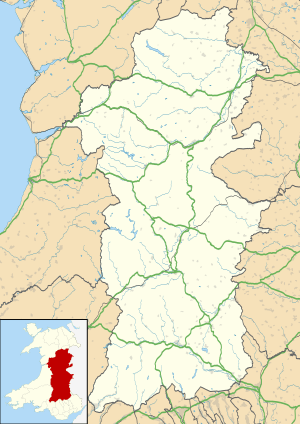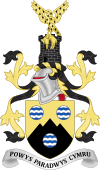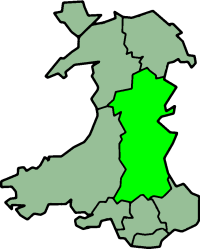Powys facts for kids
Quick facts for kids
Powys
|
||
|---|---|---|
|
County and preserved county
|
||
|
||
|
||
 |
||
| Sovereign state | ||
| Country | ||
| Preserved county | Powys | |
| Established | 1 April 1996 | |
| Admin HQ | County Hall, Llandrindod Wells | |
| Largest town | Newtown | |
| Government | ||
| • Type | Unitary authority | |
| Area | ||
| • Total | 5,181 km2 (2,000 sq mi) | |
| Area rank | Ranked 1st | |
| Population
(2015)
|
||
| • Total | 132,600 | |
| • Rank | Ranked 11th | |
| • Density | 25/km2 (60/sq mi) | |
| • Density rank | Ranked 22nd | |
| • Ethnicity | 99.3% White | |
| Welsh language | ||
| • Rank | Ranked 7th | |
| • Speakers | 16.4% | |
| ISO 3166 code | GB-POW | |
| GSS code | W06000023 | |
Powys is a large county in Wales, a country that is part of the United Kingdom. It's known for its beautiful countryside, with lots of hills and mountains. Powys is the biggest county in Wales by land area. However, it has the fewest people living there compared to its size.
The county is named after an old Welsh kingdom called Powys, which existed a long time ago in the Middle Ages. Today, Powys covers the same area as three historic counties: Montgomeryshire, Radnorshire, and Brecknockshire. The biggest town in Powys is Newtown, and the main office for the county's government is in Llandrindod Wells.
Contents
Exploring Powys: Land and People
Powys is a very large area, covering about 5,188 square kilometers (2,000 square miles). It's the biggest administrative area in Wales. The county shares borders with other Welsh counties like Gwynedd and Ceredigion. It also borders English counties such as Shropshire and Herefordshire.
Towns and Population
Even though Powys is huge, it doesn't have many big cities. Most of the area is rural, meaning it's mostly countryside with small towns and villages. The largest towns include Newtown, Ystradgynlais, Brecon, and Llandrindod Wells. Because there are so few people spread out over such a large area, Powys has the lowest population density in Wales. This means there's lots of open space!
Mountains and Rivers
Much of Powys is covered by hills and mountains. The Cambrian Mountains are in the west. Two important rivers, the River Severn and the River Wye, both start in Powys, high up in the Plynlimon mountains. These rivers and their smaller streams drain most of the county. The southern part of Powys is home to the Brecon Beacons, a famous national park with stunning landscapes. There are also other upland areas like Mynydd Epynt and Radnor Forest. The only large flat area is found northwest of Welshpool.
The Welsh Language in Powys
About 16.4% of the people in Powys can speak Welsh. This number has changed over the years. Welsh speakers are mostly found in the countryside, especially around places like Machynlleth and Llanfyllin. In the past, more people spoke Welsh across the county.
A Glimpse into Powys's Past
Powys has a very long and interesting history. The county is named after an ancient Welsh kingdom that existed around 1,400 years ago. This kingdom was very powerful until it was taken over by Llywelyn ap Gruffudd in the 1260s.
Ancient History
Long before the Kingdom of Powys, people lived in these uplands. There are many signs of ancient life, including over 1,100 burial mounds. These mounds date back thousands of years, from 4000 BC to 1000 BC, mostly from the Bronze Age. You can also find 276 standing stones, which are tall stones placed upright, many also from the Bronze Age. From the Iron Age, there are 90 scheduled hillforts and other old settlement sites. These show that people have lived here for a very long time.
Old Railways
In the past, Powys had many more railway lines connecting it to other parts of Wales and England. Lines like the Mid-Wales Railway and the Oswestry and Newtown Railway used to run through the county. While many of these old lines have closed, Powys is still served by the Cambrian Line and Heart of Wales line. These lines connect towns in Powys to bigger cities like Swansea, Cardiff, and Birmingham.
The Symbols of Powys
The county of Powys has its own special coat of arms, which is like a symbol or emblem.
What the Symbols Mean
- The gold color in the coat of arms represents the richness of the area.
- Black stands for mining and the Black Mountains.
- The fountain symbol, which looks like wavy blue and white circles, represents water. This is important because Powys has many rivers and lakes and is a major water source.
- So, the coat of arms shows the hills, mountains, rivers, lakes, and industries of Powys.
The Crest and Motto
The top part of the coat of arms, called the crest, has a tower. This tower reminds us of the county's military history and old castles. Rising from the tower is a red kite, a beautiful bird that is very rare in other parts of Britain but thrives in Powys. The red kite carries a golden fleece, which is a symbol for the sheep farming that is very important in the county.
The motto of Powys is: Powys – the paradise of Wales. In Welsh, this is Powys Paradwys Cymru.
Fun Places to Visit in Powys
Powys is full of amazing places to explore, from natural wonders to historic sites.
Natural Beauty
- Black Mountains: A beautiful mountain range perfect for hiking.
- Brecon Beacons: Another stunning mountain range, part of a national park.
- Radnor Forest: A lovely area with woodlands and hills.
- Elan Valley Reservoirs: A series of beautiful lakes and dams that supply water.
- Lake Vyrnwy: A large reservoir surrounded by forests.
- Llangorse Lake: The largest natural lake in South Wales.
- Pistyll y Llyn: One of the highest waterfalls in Wales.
- Pistyll Rhaeadr: Another impressive waterfall.
Historic Castles
Powys has many old castles that tell stories of its past:
- Dolforwyn Castle
- Montgomery Castle
- Powis Castle
- Tretower Castle
- Bronllys Castle
Museums and Exhibitions
If you like learning about history and culture, Powys has many museums:
- Centre for Alternative Technology, Machynlleth: Learn about eco-friendly living.
- National Cycle Museum, Llandrindod Wells: See bikes from different eras.
- Judge's Lodging, Presteigne: Explore a historic courthouse and home.
- Powysland Museum, Welshpool: Discover local history and artifacts.
- Robert Owen Museum, Newtown: Learn about a famous social reformer.
Walking Trails
Powys is a great place for walking and exploring the countryside:
- Glyndŵr's Way: A long walking path through Powys.
- Severn Way: A very long trail that follows the River Severn.
- Taff Trail: A path for walking and cycling from Cardiff Bay to Brecon.
- Offa's Dyke Path: A historic long-distance footpath along the border with England.
- Wye Valley Walk: A path that follows the River Wye.
Heritage Railways
You can also experience history by riding on old trains:
- Brecon Mountain Railway (heritage line)
- Welshpool & Llanfair Light Railway (heritage line)
Fairtrade County
In 2007, Powys was given the special status of a Fairtrade County by The Fairtrade Foundation. This means that people in Powys support fair trade, which helps farmers and workers in other countries get a fair price for their products.
See also
 In Spanish: Powys para niños
In Spanish: Powys para niños






